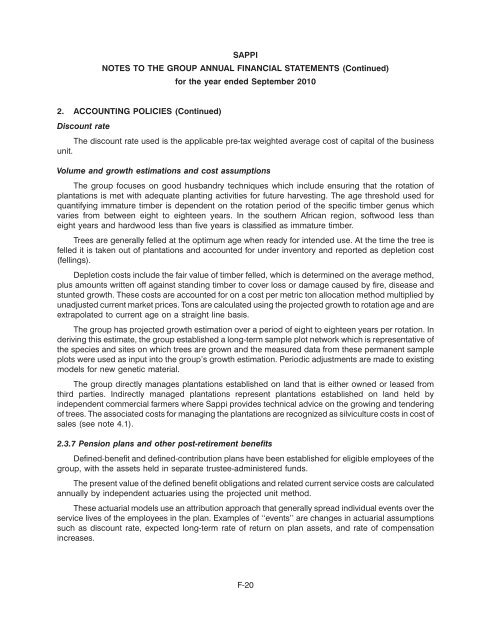You also want an ePaper? Increase the reach of your titles
YUMPU automatically turns print PDFs into web optimized ePapers that Google loves.
<strong>SAPPI</strong><br />
NOTES TO THE GROUP ANNUAL FINANCIAL STATEMENTS (Continued)<br />
for the year ended September 2010<br />
2. ACCOUNTING POLICIES (Continued)<br />
Discount rate<br />
The discount rate used is the applicable pre-tax weighted average cost of capital of the business<br />
unit.<br />
Volume and growth estimations and cost assumptions<br />
The group focuses on good husbandry techniques which include ensuring that the rotation of<br />
plantations is met with adequate planting activities for future harvesting. The age threshold used for<br />
quantifying immature timber is dependent on the rotation period of the specific timber genus which<br />
varies from between eight to eighteen years. In the southern African region, softwood less than<br />
eight years and hardwood less than five years is classified as immature timber.<br />
Trees are generally felled at the optimum age when ready for intended use. At the time the tree is<br />
felled it is taken out of plantations and accounted for under inventory and reported as depletion cost<br />
(fellings).<br />
Depletion costs include the fair value of timber felled, which is determined on the average method,<br />
plus amounts written off against standing timber to cover loss or damage caused by fire, disease and<br />
stunted growth. These costs are accounted for on a cost per metric ton allocation method multiplied by<br />
unadjusted current market prices. Tons are calculated using the projected growth to rotation age and are<br />
extrapolated to current age on a straight line basis.<br />
The group has projected growth estimation over a period of eight to eighteen years per rotation. In<br />
deriving this estimate, the group established a long-term sample plot network which is representative of<br />
the species and sites on which trees are grown and the measured data from these permanent sample<br />
plots were used as input into the group’s growth estimation. Periodic adjustments are made to existing<br />
models for new genetic material.<br />
The group directly manages plantations established on land that is either owned or leased from<br />
third parties. Indirectly managed plantations represent plantations established on land held by<br />
independent commercial farmers where Sappi provides technical advice on the growing and tendering<br />
of trees. The associated costs for managing the plantations are recognized as silviculture costs in cost of<br />
sales (see note 4.1).<br />
2.3.7 Pension plans and other post-retirement benefits<br />
Defined-benefit and defined-contribution plans have been established for eligible employees of the<br />
group, with the assets held in separate trustee-administered funds.<br />
The present value of the defined benefit obligations and related current service costs are calculated<br />
annually by independent actuaries using the projected unit method.<br />
These actuarial models use an attribution approach that generally spread individual events over the<br />
service lives of the employees in the plan. Examples of ‘‘events’’ are changes in actuarial assumptions<br />
such as discount rate, expected long-term rate of return on plan assets, and rate of compensation<br />
increases.<br />
F-20
















